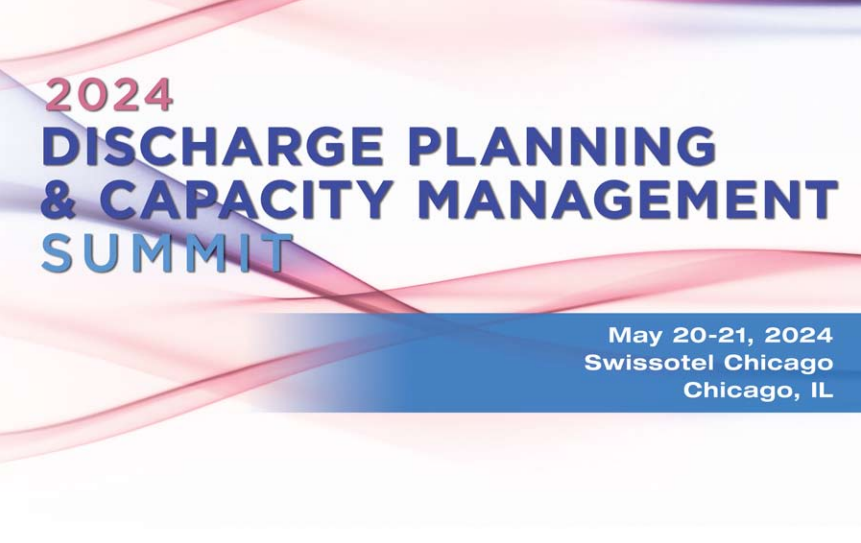2024 Discharge Planning & Capacity Management Summit
May 20-21, 2024 * Swissotel Chicago * Chicago, IL
2024 Discharge Planning & Capacity Management Summit
Day(s)
:
Hour(s)
:
Minute(s)
:
Second(s)
The conference brings together leaders from hospitals, health systems, home care, health plans and managed care organizations to discuss best practices for improving care coordination, reducing readmissions, preventing avoidable healthcare utilization, and collaborating across the continuum. Network with leading practitioners on discharge planning and learn from the success of others on how to prevent hospital readmissions through comprehensive discharge planning; move patients quickly, efficiently and safely through the hospital system; improve capacity planning and service design; enhance patient care and satisfaction; and much more.
Who Should Attend?
CEO’s
CFO’s
VP
Quality Improvement Director
Emergency Room Director
Patient Flow Director
Discharge Planning
Case Management Director
Nursing Director
Care Coordination
Utilization Review
ICU Director
Admissions Director
Hospitalists
Billing
Operations
Patient Financial Services
Medical Directors
Social Service Director
Clinical Operations Director
Patient Transportation
TeleICU
Also of Interest to Vendors/Service Providers
Conference Agenda
Day One - Monday, May 20, 2024
7:15am – 8:00am
Conference Registration & Networking Breakfast
8:00am – 8:10am
Chairperson’s Opening Remarks
8:10am – 8:50am
Reducing Length of Stay and Optimizing Capacity Through Stakeholder Collaboration and Centralized Governance
Delays in the discharging process can affect hospital efficiency. Improving patient flow in hospitals is an essential issue that hospital management aim to achieve. Hospital length of stay (LOS) is a quality metric health systems use as a proxy of efficient hospital management. Reduction in LOS improves bed turnover, allowing hospitals to match demand with capacity for elective and emergent admissions, intensive care unit (ICU) care, and interhospital transfers. When demand exceeds capacity, emergency department crowding, ICU strain, and ward strain occur, all of which are associated with worse outcomes. This session will explore interventions to reduce hospital length of stay to optimize hospital efficiency.
Sarah Ferrell Souter, FACHE
Administrator- Capacity Management and Strategy
University of Virginia Health
Michael Chilmaid, MHA
Performance Improvement Coach
UVA Health
8:50am – 9:30am
How to Improve the Hospital Discharge Processes
The hospital discharge process is an essential part of the care continuum, but without the right infrastructure, it can be a cumbersome and chaotic process. Administrators in healthcare organizations need to be actively engaged if they want to ensure that the hospital discharge process is both efficient and effective for all involved. Establishing clear goals and objectives around patient experience is paramount for any successful strategy aimed at improving your hospital’s discharge processes. Whether you’re looking at how safe discharge policies can improve recovery times or exploring new technologies that streamline operations, there are countless ways to optimize your approach so that everyone benefits from a seamless transition.
This session will cover key strategies that you can implement at your own hospital to optimize the discharge process.
Andrew Zinkel, MD, MBA, FACEP
Senior Executive Medical Director of Emergency Medicine
University of Minnesota Medical Center
9:30am – 10:00am
Networking & Refreshments Break
10:00am – 10:40am
Optimizing Healthcare Efficiency: The Role of the Throughput Governance Council in Enhancing Hospital Operations through Data-driven Strategies
A strategic approach to optimizing patient throughput in healthcare settings through the utilization of data-driven methodologies and the establishment of a Throughput Governance Council composed of key stakeholders. By leveraging electronic health records, real-time monitoring, and data analytics, healthcare organizations can identify operational inefficiencies and implement targeted interventions to enhance patient flow. The formation of a Throughput Governance Council, comprising representatives from clinical, administrative, and technical domains, facilitates collaborative decision-making based on data insights. This framework ensures a multidisciplinary and continuous improvement approach to throughput management, fostering a culture of adaptability and efficiency within the healthcare system.
Leah Davenport, RN
Throughput Manager
Ascension Saint Thomas Rutherford
10:40am – 11:20am
Discharging Patients to Post-Acute Care Settings
Last year, CMS provided a Quality Safety & Oversight (QSO) memorandum outlining CMS-identified concerns with respect to the patient discharge process. As set forth within, hospitals must have “an effective discharge planning process that focuses on the patient’s goals and treatment preferences and includes the patient and his or her caregivers/support person(s) as active partners in the discharge planning for post-discharge care.” Within the memo, CMS emphasized the importance of ensuring that post-acute care (PAC) providers, including skilled nursing facilities and home health agencies, are provided with accurate and complete information relating to a patient’s condition and treatment in order to protect and improve a patient’s health and safety. According to CMS, the consequences of inaccurate and incomplete information lead to “avoidable readmissions, complications, and other adverse events.” This session will explore this and how important it is that hospitals and PAC providers to shore up their discharge procedures to ensure that both the PAC providers and the discharged patients are properly supported.
Vipul Bhatia, MD, MBA
Associate Chief Medical Officer, Post-Acute & Continuing Care Services
WellSpan Health
11:20am – 12:00pm
Streamlining Medical Transportation Discharges: An EHR-connected approach to reducing LOS, eliminating phone calls, decreasing wait times, and bringing real-time ETAs to the process directly from the patient’s chart.
In today’s post covid environment, lack of transportation options and resources are causing significant delays. Multiple, time-consuming phone calls and manual paper processes are also impeding patient flow. The ability to reach multiple transportation providers with a single, online order, get real time ETAs and electronically sign medical necessity forms without leaving the patient chart saves time and money. This session will explore how care coordinators and clinical staff can benefit from an embedded EHR platform to order, manage, and track transportation and related authorizations directly from the patient’s chart.
Chris Hamilton, RN
Chief Executive Officer
Movi Healthcare
12:00am – 12:40pm
Strategies within the Emergency Department to Improve Patient Flow and Hospital Capacity
Efficient patient flow within the Emergency Department (ED) is pivotal for delivering timely and high-quality care, as well as for optimizing overall hospital capacity. This presentation explores various strategies implemented in the ED to improve patient flow, improve quality of care, and enhance hospital resource utilization.
Patrice Callagy, RN, MPA, MSN, CEN
Executive Director, Emergency Services
Stanford Health Care
Shashank Ravi, MD MBA FACEP
Medical Director of Quality, Adult Emergency Department; Medical Director of Value Based Care
Stanford Health Care
12:40pm – 1:30pm
Luncheon
1:30pm – 2:10pm
Leveraging Technology to Improve Discharge Planning
There are pressures on hospitals to reduce the readmissions and improve patient satisfaction. These two factors are important for hospital growth as they can be penalized for higher readmission rates and can be incentivized for higher patient satisfaction. Based on studies, approximately 15 percent of elderly patients are readmitted within 28 days of discharge. This session will explore the latest cutting-edge technologies, including cloud, artificial intelligence/machine learning, and mobile enablement that can play an important role in increasing patient’s post-discharge engagement, and ways hospital scan use technology to improve patient engagement and to help increase patient satisfaction and reducing readmissions.
Kendall L. Webb MD FACEP FAMIA ABPM-CI
CMIO
University of Florida at Jacksonville
2:10pm – 3:00pm
Panel: Effective Patient Engagement Strategies to Prevent Hospital Readmission
A key metric in most value-based care models, hospital readmission rates measure the proportion of patients who are readmitted back into the hospital after discharge. Many hospitals look at their readmission rates at different intervals—30, 60, and 180 days—but most payment models primarily look at the 30-day all-cause hospital readmission rate to determine hospital payment. Reducing hospital readmissions can be difficult because it depends on numerous variables. In addition to delivering high-quality care, providers must motivate patients to engage in post-discharge care management and ensure the patient’s condition does not unpredictably worsen. This session will explore how healthcare professionals can work to reduce hospital readmissions using key patient engagement strategies, including identifying their high-risk patients, engaging them during the care planning process, practicing strong patient follow-up, and addressing the social determinants of health.
Vipul Bhatia, MD, MBA
Associate Chief Medical Officer, Post-Acute & Continuing Care Services
WellSpan Health
Andrew Zinkel, MD, MBA, FACEP
Senior Executive Medical Director of Emergency Medicine
University of Minnesota Medical Center
Robert Fogerty
Senior Medical Director, Yale New Haven Hospital
Associate Clinical Professor, Yale School of Medicine
Iqbal Shariff, MBA
CEO
Best Home Healthcare Network
3:00pm – 3:30pm
Networking & Refreshments Break
3:30pm – 4:10pm
Reimagining Your Command Center Strategy, Uniting AI, Automation, and Change Management to Increase Patient Access
Joe Versino
National Director – Inpatient Flow
LeanTaaS
4:10pm – 4:50pm
Pitfalls and Perils of Emergency Department Discharge
In the emergency department, failure to comply with discharge instructions has been associated with an increased rate of adverse outcomes for patients. There is tremendous variability in the information that is provided to patients in discharge paperwork. In some EDs, a simple handwritten discharge note is given to the patient, while in others, extensive, diagnosis specific pre-created instructions are provided to patients at time of discharge. This session will examine how to reduce risk at discharge, key elements that healthcare providers must recognize as part of all discharge processes in the ED, and some suggest “best practices” to improve patient outcomes.
Keith Grams, MD FACEP
System Chair, Emergency Medicine
Rochester Regional Health
4:50-5:30pm
Building Physician Engagement in Discharge Planning
Physicians are critical stakeholders in the discharge of admitted patients from an acute care hospital. The role of physician is a critical, and in some cases the rate limiting, factor in the timing of discharge, nature of discharge, immedate and long term post discharge plans, and the patient experience of the discharge. Unfortunately, physicians are commonly not fully involved in the improvement or change of discharge procedures, protocols, and standards. This disconnect can lead to inefficiency and frustration. Building a supported and engaged physician workforce, including local physician leadership, can be an asset in improving discharge processes.
Robert Fogerty
Senior Medical Director, Yale New Haven Hospital
Associate Clinical Professor, Yale School of Medicine
5:30pm
Cocktail Reception
Day Two – Tuesday, May 21, 2024
Networking Breakfast
8:00am – 8:15am
Chairperson’s Recap
8:15am – 9:00am
How to Improve the Hospital Discharge Processes
The hospital discharge process is an essential part of the care continuum, but without the right infrastructure, it can be a cumbersome and chaotic process. Administrators in healthcare organizations need to be actively engaged if they want to ensure that the hospital discharge process is both efficient and effective for all involved. Establishing clear goals and objectives around patient experience is paramount for any successful strategy aimed at improving your hospital’s discharge processes. Whether you’re looking at how safe discharge policies can improve recovery times or exploring new technologies that streamline operations, there are countless ways to optimize your approach so that everyone benefits from a seamless transition.
This session will cover key strategies that you can implement at your own hospital to optimize the discharge process.
Andrew Zinkel, MD, MBA, FACEP
Senior Executive Medical Director of Emergency Medicine
University of Minnesota Medical Center
9:00am – 9:45am
Discharge Planning and Transitions of Care
Transitions of care refer to the movement of patients between different healthcare settings such as from an ambulance to the emergency department, an intensive care unit to a medical ward, and the hospital to home. The transition from hospital to home can be challenging as patients and families become responsible for care coordination. Hospital discharges are complicated and often lack standardization. Patients receive an onslaught of new information, medications and follow-up tasks such as scheduling appointments with primary care providers. Suboptimal transitions of care increase the risk of readmissions and adverse drug events after discharge. The discharge process can be influenced by characteristics and activities of the health system, patient, and clinician. Discharge instructions may differ between providers, or may not be tailored to a patient’s level of health literacy or current health status. Prior studies have shown that an early discharge preparation process can significantly decrease hospital length of stay (LOS), readmission risk and mortality risk. As such, discharge planning should begin as soon as possible. This session will explore the importance of transitions of care in discharge planning.
Carissa J. Tyo, MD FACEP
Associate Professor of Internal and Emergency Medicine
Medical Director, Clinical Decision Unit
Medical Director, Care Management and Physician Advisors
University of Illinois Hospital
9:45am – 10:15am
Networking & Refreshments Break
10:15am – 11:00am
Improving Early Discharges with an Electronic Health Record Discharge Optimization Tool
Delays in hospital discharge can negatively impact patient care, bed availability, and patient satisfaction. Obtaining accurate clinical information about recent acute care visits is extremely important for outpatient providers. However, documents used to communicate this information are often difficult to use. This puts patients at risk of adverse events. Elderly patients who are seen by more providers and have more care transitions are especially vulnerable. Hospitals have increasingly focused on optimizing patient flow to improve care and reduce potential harm. Discharge delays prevent newly admitted patients from being placed in the right bed at the right time, often leading to emergency department overcrowding, patient dissatisfaction, and adverse events. During high-census periods, the lack of available inpatient beds can lead to the diversion of critically ill patients, canceled surgical procedures, or postponement of scheduled admissions. This session will explore how could be created in the EHR to assist medical care teams with improving DBN percentage on busy, academic teaching services.
Anu Banerjee, PhD, FACHE
Chief Executive Officer
CCHCS
11:00am – 11:45am
Thoughtful Patient Progression to Ensure Safe Discharges
Safe discharge should be the goal of any hospital admission. Wanting it and achieving it are two different things. Too often, organizations default to keeping patients in the hospital for far too many days or weeks because there are barriers to safe discharge. Establishing a target or anticipated discharge date on admission, eliminating wasted time in the hospital waiting for diagnostics or treatment plans, and failing to communicate in real time with patients and families will profoundly prolong patient stays. Longer stays, mean even longer stays as hospital acquired conditions develop over time. Establishing a goal for planned discharge, documenting changes in patient conditions when they don’t meet that goal, and systematically eliminating barriers that prevent patients from leaving when they need to move to the next phase of their care are the key to safe discharge.
This session will provide:
- A Framework for safe and timely discharge
- An outline for goal establishment and anticipated date of discharge
- A robust methodology for identifying and eliminating barriers in the time allotted to provide care based on the patient’s diagnosis
- A guide for driving provider documentation that is critical to capturing complications and delays in order to ensure safe discharge for the patient, and enhanced case mix index for the institution
Joseph A. Bick, MSN, RN, NE-BC
Director of Clinical Operations
St Joseph’s Health, Syracuse, NY
11:45-12:30pm
Morning Momentum: Mastering the Art of Timely Discharges – Lessons Learned from our Early BirdInitiative
Meagan will unravel the narrative of Ascension Saint Thomas’s Early Bird Initiative, a concerted effort to optimize the efficiency of daily hospital discharges before noon. The discourse will navigate through the strategic interventions deployed, emphasizing streamlined processes, heightened collaboration among healthcare teams, and valuable lessons learned for sustainment.
Meagan Davis, MHA, BSN, RN, CLSSGB, CEN
Performance Improvement Specialist
Ascension Saint Thomas Performance Excellence
12:30pm
Conference Concludes
Workshop - Tuesday, May 21, 2024
The combination of an aging nursing population and not enough new nurses coming in to fill those roles plays a large part in today’s nursing shortage. The nurse shortage is making it more difficult for hospitals to efficiently and appropriately discharge patients. According to the American Nursing Association, registered nurses who are less than 30 years old represent only 10 percent of the total working nurse population. The roles served by nurses are critical to the health of the enterprise and ultimately, in driving positive outcomes for the patients receiving care. Amid an increasing nursing shortage, nurse leaders must find the best way to recruit and retain staff. This session will explore leadership strategies that hospital senior nurse managers use improve nurse retention.
Donna McHale
Principal
Huron Consulting Group
Featured Speakers

Sarah Ferrell Souter, FACHE
Administrator- Capacity Management and Strategy
University of Virginia Health
Penny Porteous, MSHA, BSN, RN
Executive Director Capacity Management & EMS Transport
AdventHealth Orlando Florida
Leah Davenport, RN
Throughput Manager
Ascension Saint Thomas Rutherford
Vipul Bhatia, MD, MBA
Associate Chief Medical Officer, Post-Acute & Continuing Care Services
WellSpan Health
Patrice Callagy, RN, MPA, MSN, CEN
Executive Director, Emergency Services
Stanford Health CareShashank Ravi, MD MBA FACEP
Medical Director of Quality, Adult Emergency Department
Medical Director of Value Based CareStanford Health Care

L. Kendall Webb MD FACEP FAMIA ABPM-CI
Professor
Executive Medical Director of EHR Integration and InnovationUniversity of Florida, Jacksonville
Department of Emergency Medicine

Andrew Zinkel, MD, MBA, FACEP
Senior Executive Medical Director of Emergency Medicine
University of Minnesota Medical Center
Robert Fogerty
Senior Medical Director, Yale New Haven Hospital
Associate Clinical Professor, Yale School of Medicine
Keith Grams, MD FACEP
System Chair, Emergency Medicine
Rochester Regional Health
Carissa J. Tyo, MD FACEP
Associate Professor of Internal and Emergency Medicine
Medical Director, Clinical Decision UnitMedical Director, Care Management and Physician Advisors
University of Illinois Hospital

Anu Banerjee, PhD, FACHE
Chief Executive Officer
CCHCS
Joseph A. Bick, MSN, RN, NE-BC
Director of Clinical Operations
St Joseph’s Health, Syracuse, NY
Meagan Davis, MHA, BSN, RN, CLSSGB, CEN
Performance Improvement Specialist
Ascension Saint Thomas Performance Excellence
Donna McHale
Principal
Huron Consulting Group
Joe Versino
National Director - Inpatient Flow
LeanTaaS
Venue
Swissotel Chicago
323 E. Wacker Drive
Chicago, IL 60601
312-565-0565
Mention BRI Network to get discounted rate of $289/night or use link below: (ROOM BLOCK CLOSES APRIL 19th)
Sponsors and Exhibitors
FAQ
Are there group discounts available?
- Yes – Register a group of 3 or more at the same time and receive an additional 10% off the registration fee
Are there discounts for Non-Profit/Government Organizations?
- Yes – please call us at 800-743-8490 for special pricing
What is the cancellation policy?
- Cancellations received 4 weeks prior to the event will receive a refund minus the administration fee of $225. Cancellation received less than 4 weeks prior to the event will receive a credit to a future event valid for one year.
Can the registration be transferred to a colleague?
- Yes – please email us in writing at info@brinetwork.com with the colleague’s name and title
Where can I find information on the venue/accommodations?
- Along with your registration receipt you will receive information on how to make your hotel reservations. You can also visit individual event page for specific hotel information. The conference fee does not include the cost of accommodations.
What is the suggested dress code?
- Business casual. Meeting rooms can sometimes be cold so we recommend a sweater or light jacket
Request Brochure
Register Your Team Today!
Register Now
Register by April 19th & Save an Additional $200 off the Registration Fee – Mention Promo Code WB200!









